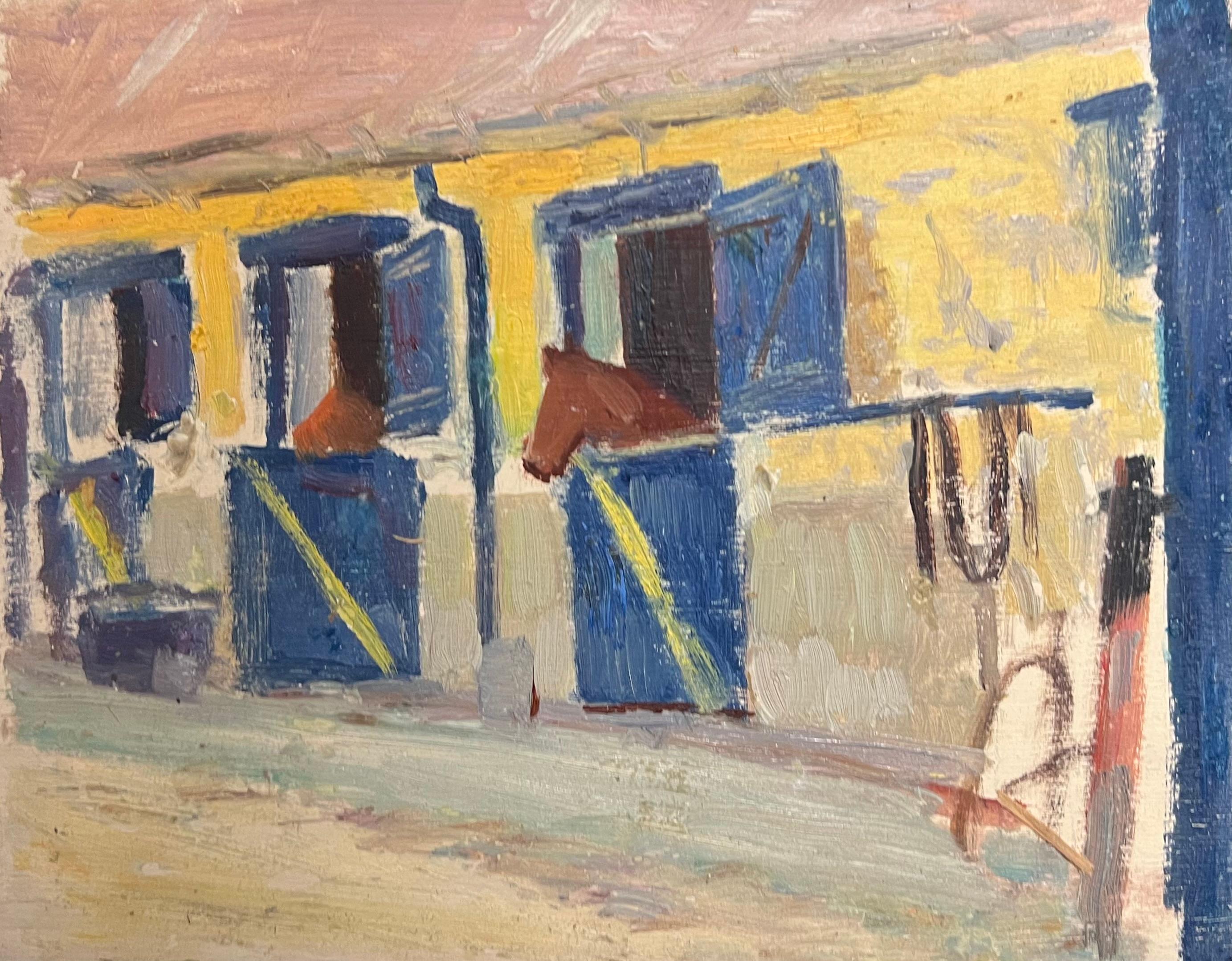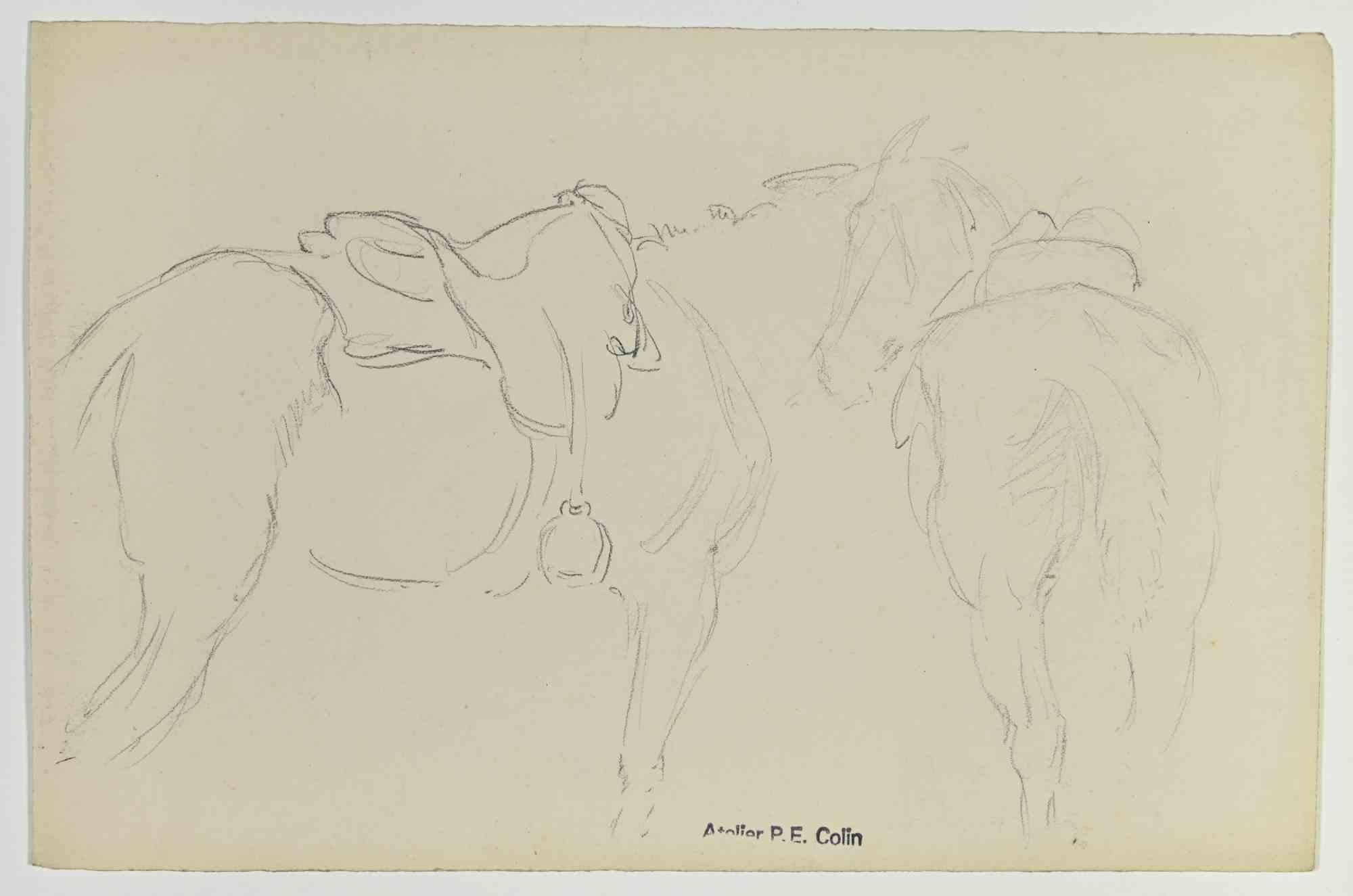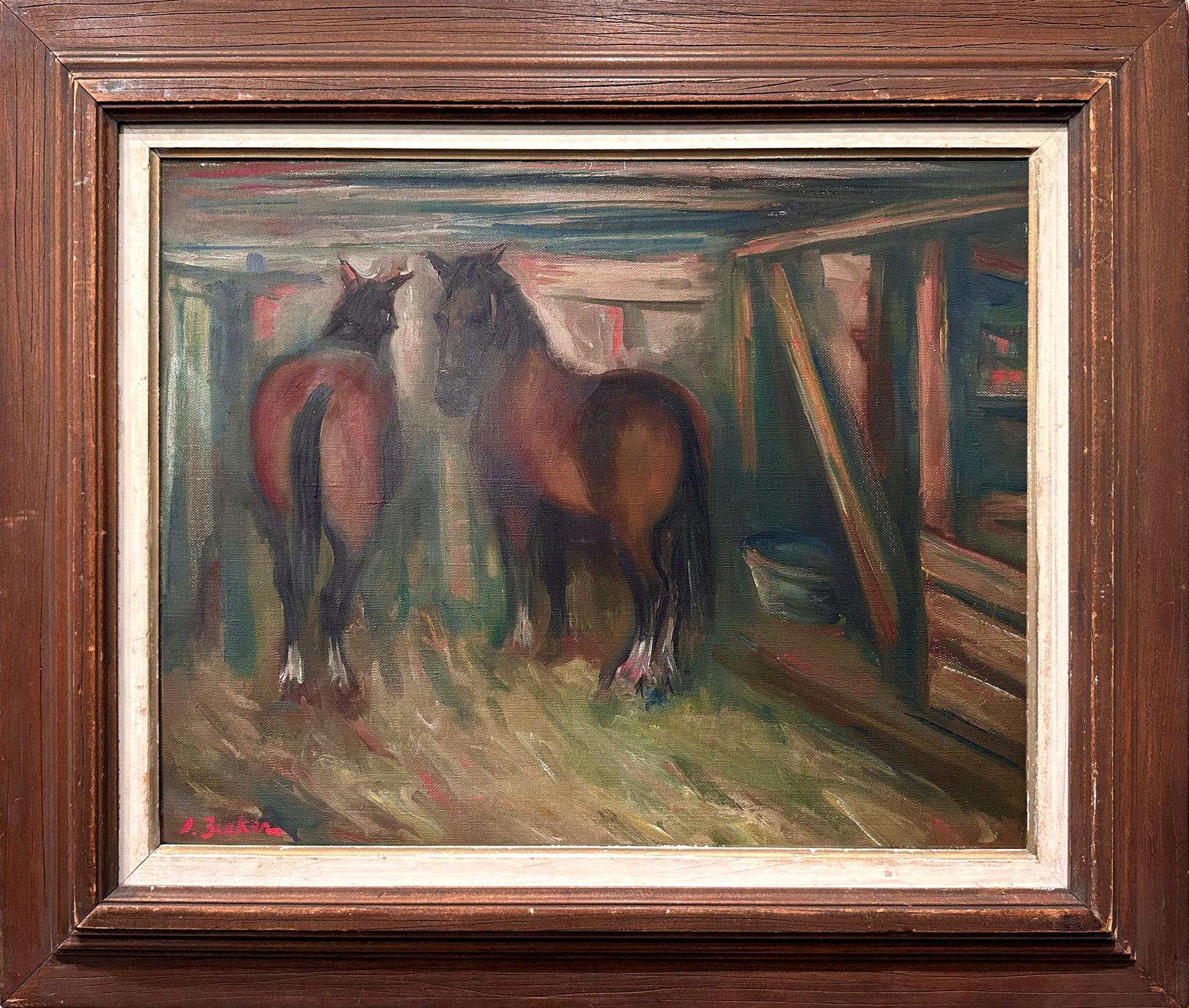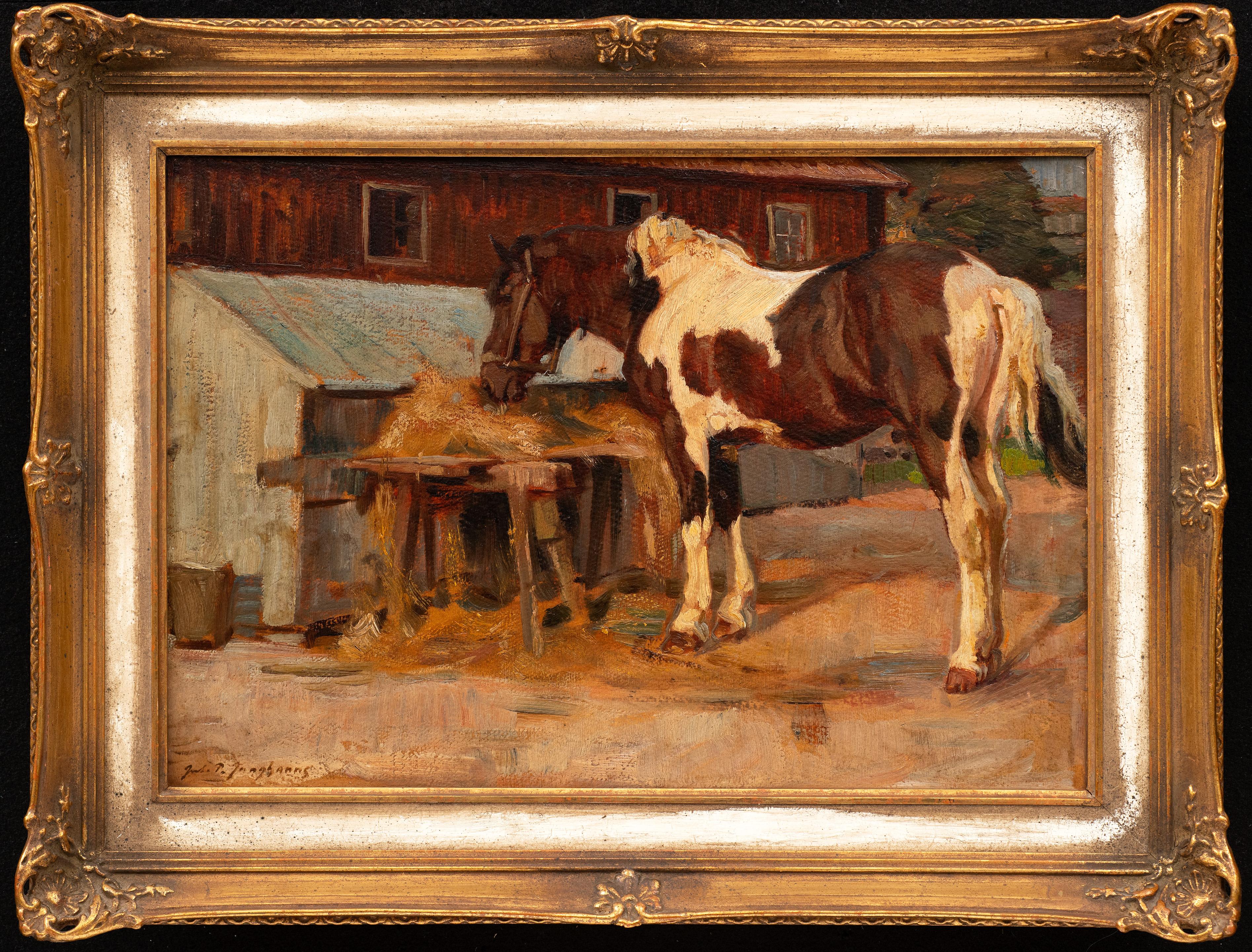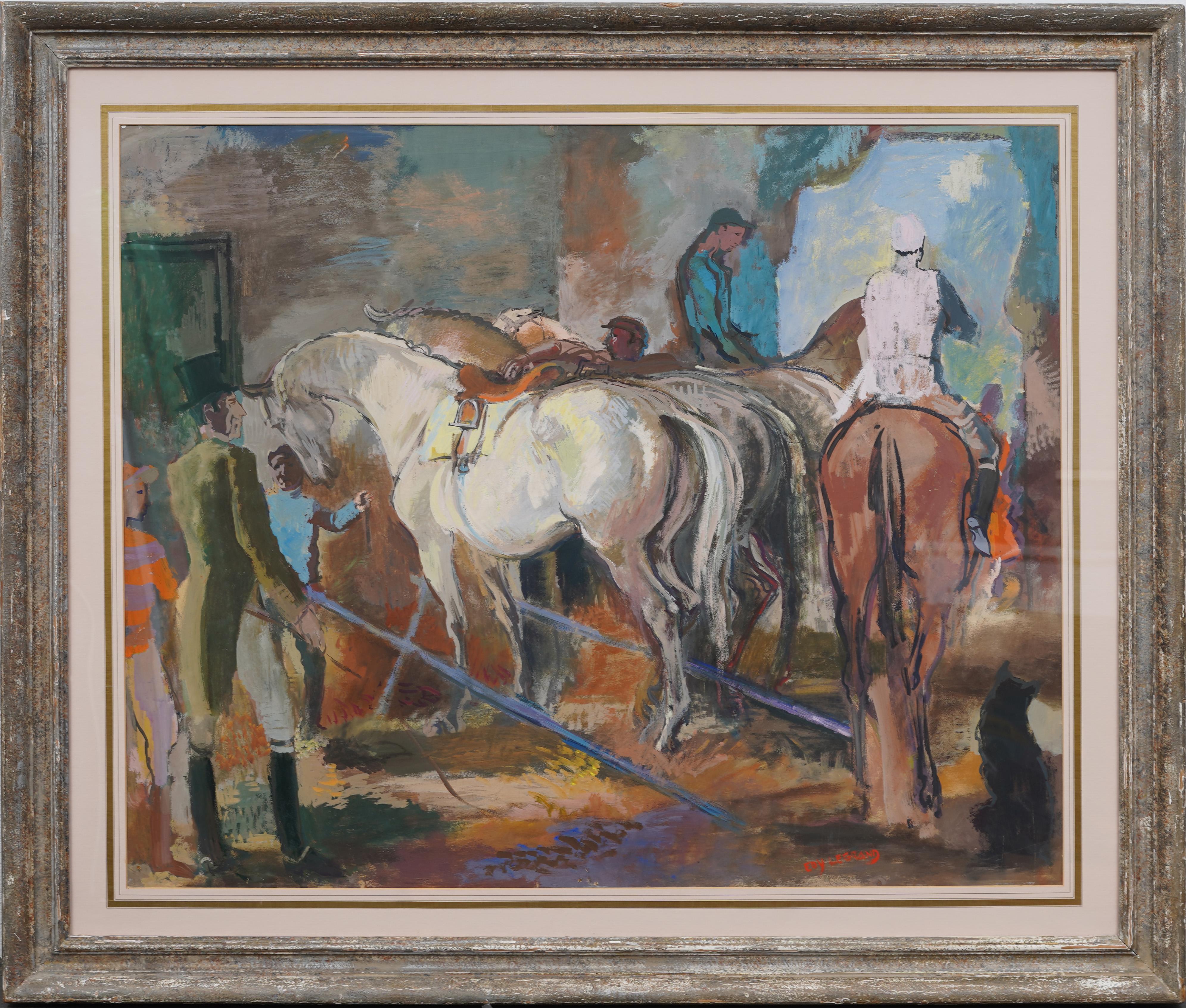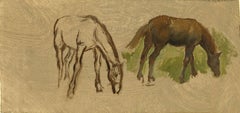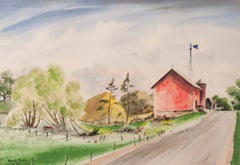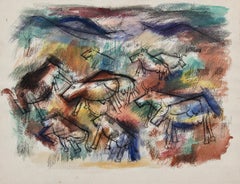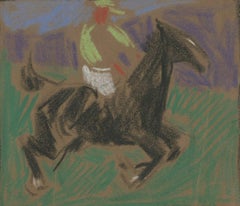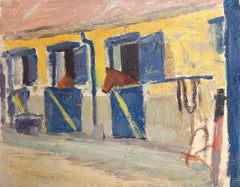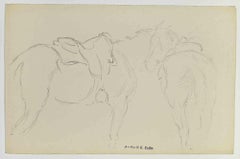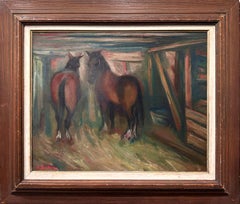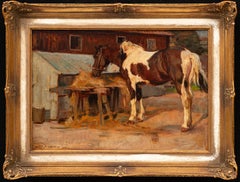Items Similar to Horses in Stable
Want more images or videos?
Request additional images or videos from the seller
1 of 10
Georges LemmenHorses in Stable1896
1896
$2,750
£2,078.66
€2,388.75
CA$3,829.36
A$4,260
CHF 2,233.15
MX$52,056.21
NOK 28,436.35
SEK 26,768.89
DKK 17,831.10
Shipping
Retrieving quote...The 1stDibs Promise:
Authenticity Guarantee,
Money-Back Guarantee,
24-Hour Cancellation
About the Item
Horses in a Stable
Black chalk on tan wove paper, 1896
Signed with the estate stamp lower right corner
(see photo)
Note: The image has been sqaured off in red chalk grid lines for use in a large painting
Dated in charcoal lower right: "23 Nov '96"
Condition: Tack holes in the corners
small tears and creases along margins
Sheet size: 14 11/16 x 16 13/16 inches
Provenance: Dr. Ernst Hauswedell
Brenner Fine Arts, Inc., New York
Alan Stone Gallery, New York
"Georges Lemmen was the son of an architect and studied under Amédée Bourson at the academy in St Joost-ten-Node. He was invited in 1889 to join the Group of Twenty ( Cercle des XX) which had been launched in 1884 by Oscar Maus and had in the interim emerged as an influential force in Belgian artistic circles, not least by bringing to public and critical attention the work of such artists as Georges Seurat and Paul Signac. The Cercle des XX would be reborn in 1894 as La Libre Esthétique.
In the early days of the Cercle des XX, Lemmen espoused a pointilliste technique. His earlier painting was clearly influenced by the Neo-Impressionists; over time, however, his style became more subtle and nuanced – recalling, perhaps, that of his compatriot Van Rysselberghe, another Cercle des XX member. With the group’s rebirth as the Libre Esthétique, Lemmen’s work became more intimiste in character, most notably in his portraits, nudes and still-lifes, where the influence of Bonnard and Vuillard is unmistakable, as is that of Renoir, particularly after Lemmen’s travels in the Midi in 1911. From this point onwards, he would go on to make a major contribution to the renewal of the graphic and decorative arts in terms of his input to the new ‘free’ aesthetic and to Art Nouveau. Although his draughtsmanship retained its essential purity and elegance of line, his painting became more fleshy, imprecise and sensual, his compositions governed less by technical considerations than by the urgent need to express his emotions.
Between 1889 and 1893, Lemmen exhibited at the Salon des Indépendants in Paris, aligning himself with the Neo-Impressionists. In 1893, Henry van de Velde invited him to participate in the Pour l’Art association that had been created in Antwerp. He travelled to the south of France in 1911. By this juncture, he had already exhibited solo on two occasions (in 1906 and 1908) at the Galerie Druet in Paris. A further solo exhibition in 1913, his first in Brussels, cemented Lemmen’s reputation.
Museum and Gallery Holdings
Bremen (Kunsthalle): Standing Nude Combing her Hair
Brussels (Mus. royaux des Beaux-Arts de Belgique): Children’s Room (watercolour); Reading; Couture; Young Girl by the Sea (1913)
Ixelles: posters
Ostend (Mus. voor Schone Kunsten)
Paris (Mus. d’Orsay): River Thames; Portrait of Madame Lemmen (drawing)"
Courtesy Leighton Fine Art
- Creator:Georges Lemmen (1865 - 1916, Belgian)
- Creation Year:1896
- Dimensions:Height: 14.59 in (37.06 cm)Width: 16.82 in (42.73 cm)
- Medium:
- Movement & Style:
- Period:
- Condition:Tack holes in the corners, small tears and creases along margins.
- Gallery Location:Fairlawn, OH
- Reference Number:Seller: FA109801stDibs: LU14015089822
About the Seller
5.0
Recognized Seller
These prestigious sellers are industry leaders and represent the highest echelon for item quality and design.
Gold Seller
Premium sellers maintaining a 4.3+ rating and 24-hour response times
Established in 1978
1stDibs seller since 2013
798 sales on 1stDibs
Typical response time: <1 hour
Associations
International Fine Print Dealers Association
- ShippingRetrieving quote...Shipping from: Fairlawn, OH
- Return Policy
Authenticity Guarantee
In the unlikely event there’s an issue with an item’s authenticity, contact us within 1 year for a full refund. DetailsMoney-Back Guarantee
If your item is not as described, is damaged in transit, or does not arrive, contact us within 7 days for a full refund. Details24-Hour Cancellation
You have a 24-hour grace period in which to reconsider your purchase, with no questions asked.Vetted Professional Sellers
Our world-class sellers must adhere to strict standards for service and quality, maintaining the integrity of our listings.Price-Match Guarantee
If you find that a seller listed the same item for a lower price elsewhere, we’ll match it.Trusted Global Delivery
Our best-in-class carrier network provides specialized shipping options worldwide, including custom delivery.More From This Seller
View AllOil Study of Two Horses
By Frederic A. Bridgeman
Located in Fairlawn, OH
Oil Study of Two Horses
Oil on canvas, c. 1880
Unsigned
Estate stamp verso of canvas and on stretcher (see photo)
Condition: Excellent
New gilt frame aptterned afte...
Category
1880s American Realist Animal Paintings
Materials
Oil
Horses Leaving the Barn
By Adolf Dehn
Located in Fairlawn, OH
Horses Leaving the Barn
Watercolor on paper, 1940
Signed and dated lower left corner (see photo)
Condition: Excellent
Image: 14 1/2 x 21”
Frame: 25” x 31”
Provenance; Associated American Artists, New York (see photo of label)
Mamdouha and Elmer Holmes Bobst
Displayed in an original wormy chestnut frame with OP3 Acrylic. Most probably from the AAA Dehn watercolor exhibition of 1940. Vintage original framing chosen by the artist.
Note: Elmer Holmes Bobst (1884–1978) was an American businessman and philanthropist who worked in the pharmaceutical industry. His wife, Mamdouha, was also well known philanthropist.
Bobst was born in Lititz, Pennsylvania. He aspired to become a doctor, but instead, he taught himself pharmacology. After his wife Ethel composed his interview letter, he became manager and treasurer of the Hoffman-LaRoche Chemical Works by 1920. When Bobst retired from the company in 1944, he was one of the nation's highest paid corporate executives. In 1945 he took charge of the ailing William Warner Company (later Warner–Lambert) and he remained board chairman until his retirement.
Bobst had close connections to President Dwight Eisenhower, but was also a close friend of President Richard Nixon.
Note: In 1940, the year of this watercolor, Dehn and Elizabeth Timmerman visited Waterville, MN on their way to Colorado Sprint, Colorado where Dehn was to teach lithography and watercolor. This watercolor is obviously a view of the area around Waterville.
Adolf Dehn, American Watercolorist and Printmaker, 1895-1968
Adolf Dehn was an artist who achieved extraordinary artistic heights, but in a very particular artistic sphere—not so much in oil painting as in watercolor and lithography. Long recognized as a master by serious print collectors, he is gradually gaining recognition as a notable and influential figure in the overall history of American art.
In the 19th century, with the invention of the rotary press, which made possible enormous print runs, and the development of the popular, mass-market magazines, newspaper and magazine illustration developed into an artistic realm of its own, often surprisingly divorced from the world of museums and art exhibitions, and today remains surprisingly overlooked by most art historians. Dehn in many regards was an outgrowth of this world, although in an unusual way, since as a young man he produced most of his illustrative work not for popular magazines, such as The Saturday Evening Post, but rather for radical journals, such as The Masses or The Liberator, or artistic “little magazines” such as The Dial. This background established the foundation of his outlook, and led later to his unique and distinctive contribution to American graphic art.
If there’s a distinctive quality to his work, it was his skill in introducing unusual tonal and textural effects into his work, particularly in printmaking but also in watercolor. Jackson Pollock seems to have been one of many notable artists who were influenced by his techniques.
Early Years, 1895-1922
For an artist largely remembered for scenes of Vienna and Paris, Adolf Dehn’s background was a surprising one. Born in Waterville, Minnesota, on November 22, 1895, Dehn was the descendent of farmers who had emigrated from Germany and homesteaded in the region, initially in a one-room log cabin with a dirt floor. Adolf’s father, Arthur Clark Dehn, was a hunter and trapper who took pride that he had no boss but himself, and who had little use for art. Indeed, during Adolf’s boyhood the walls of his bedroom and the space under his bed were filled with the pelts of mink, muskrats and skunks that his father had killed, skinned and stretched on drying boards. It was Adolf’s mother, Emilie Haas Dehn, a faithful member of the German Lutheran Evangelical Church, who encouraged his interest in art, which became apparent early in childhood. Both parents were ardent socialists, and supporters of Eugene Debs...
Category
1940s American Realist Landscape Drawings and Watercolors
Materials
Watercolor
Cows in a Field (Recto) Two Figures in an Interior (Verso)
By Louis Schanker
Located in Fairlawn, OH
Cows in a Field (Recto)
Two Figures in an Interior (Verso)
Watercolor on heavy textured paper, 1938
Signed in ink verso image of Two Figures, unsigned ...
Category
1930s American Modern Landscape Drawings and Watercolors
Materials
Watercolor
untitled (polo player on horseback)
By Henry George Keller
Located in Fairlawn, OH
untitled (polo player on horseback)
Chalk on tan paper, c. 1920
Unsigned
Provenance: Gift of the artist
William McGill (Keller's student)
Image size: 4 3/8 x 5 ...
Category
1920s American Impressionist Animal Drawings and Watercolors
Materials
Chalk
Farm Horse Drinking
By Edmund Blampied
Located in Fairlawn, OH
Farm Horse Drunking
Charcoal and pastel on artist's board, c. 1920
Signed lower right in pencil (see photo)
Titled in ink lower center, as are all the illustration for At the Farm (s...
Category
1920s English School Animal Drawings and Watercolors
Materials
Chalk
untitled (The White Barn with Farmers and Horse)
By William Grauer
Located in Fairlawn, OH
untitled (The White Barn with Farmers and Horse)
Watercolor, c. 1950
Signed by the artist in ink lower right: Wm. C. Grauer
Numbered in pencil verso: 152
Provenance:
Estate of the Ar...
Category
1950s American Realist Landscape Drawings and Watercolors
Materials
Watercolor
You May Also Like
Vintage French Stable Scene Impressionist Oil Painting of Horses in Their Stalls
Located in Cirencester, Gloucestershire
Charming Stable Scene
by Jean Dreyfus-stern (1890-1969)
signed verso
oil on board, unframed
Board : 7.5 x 9.5 inches
Provenance: private collection, Paris
Condition: very good condit...
Category
Mid-20th Century Post-Impressionist Animal Paintings
Materials
Oil
Horses - Drawing by Paul Emile Colin - Early-20th century
Located in Roma, IT
Horses is a drawing realized by Paul Emile Colin in the Early 20th Century.
Carbon Pencil on ivory-colored paper
Stamped on the lower.
Good conditions with slight foxing.
The art...
Category
Early 20th Century Modern Landscape Drawings and Watercolors
Materials
Pencil
"Horses in Stable" Post-Impressionist Pastoral Interior Oil Painting on Canvas
By Jacques Zucker
Located in New York, NY
A charming oil painting depicting two brown horses inside of a stable, with details of the wooden structure and the hay on top of the floor. Done in a highly impressionistic manner w...
Category
20th Century Post-Impressionist Animal Paintings
Materials
Canvas, Oil
Horse Painting: "Horse at Stable with Hay" -Julius Paul Junghanns (1876-1958)
Located in SANTA FE, NM
Antique Horse Painting
"Horse at Stable with Hay"
Julius Paul Junghanns (German, 1876-1958)
Oil on canvas on board (marouflé )
20 1/4 x 14 (25 ...
Category
Early 20th Century Post-Impressionist Animal Paintings
Materials
Canvas, Oil, Board
Large Vintage American Modernist Horse Barn Landscape Framed Equestrian Painting
Located in Buffalo, NY
Antique French American modernist horse barn painting. Mixed media painting on paper. Framed. Signed. Measuring 41 by 49 inches overall and 31.5 by 39.5 painting alone. In excellent ...
Category
1950s Modern Animal Paintings
Materials
Board, Watercolor, Gouache
Mid-Century French Feutre on Paper. In the Stables..
Located in Cotignac, FR
Mid Century French feutre drawing on paper of a Provençal stable with horses by Jean Arène. Signed and dated bottom left and presented in a wooden frame under glass.
This evocative...
Category
Mid-20th Century Expressionist Figurative Drawings and Watercolors
Materials
Paper, Felt Pen
